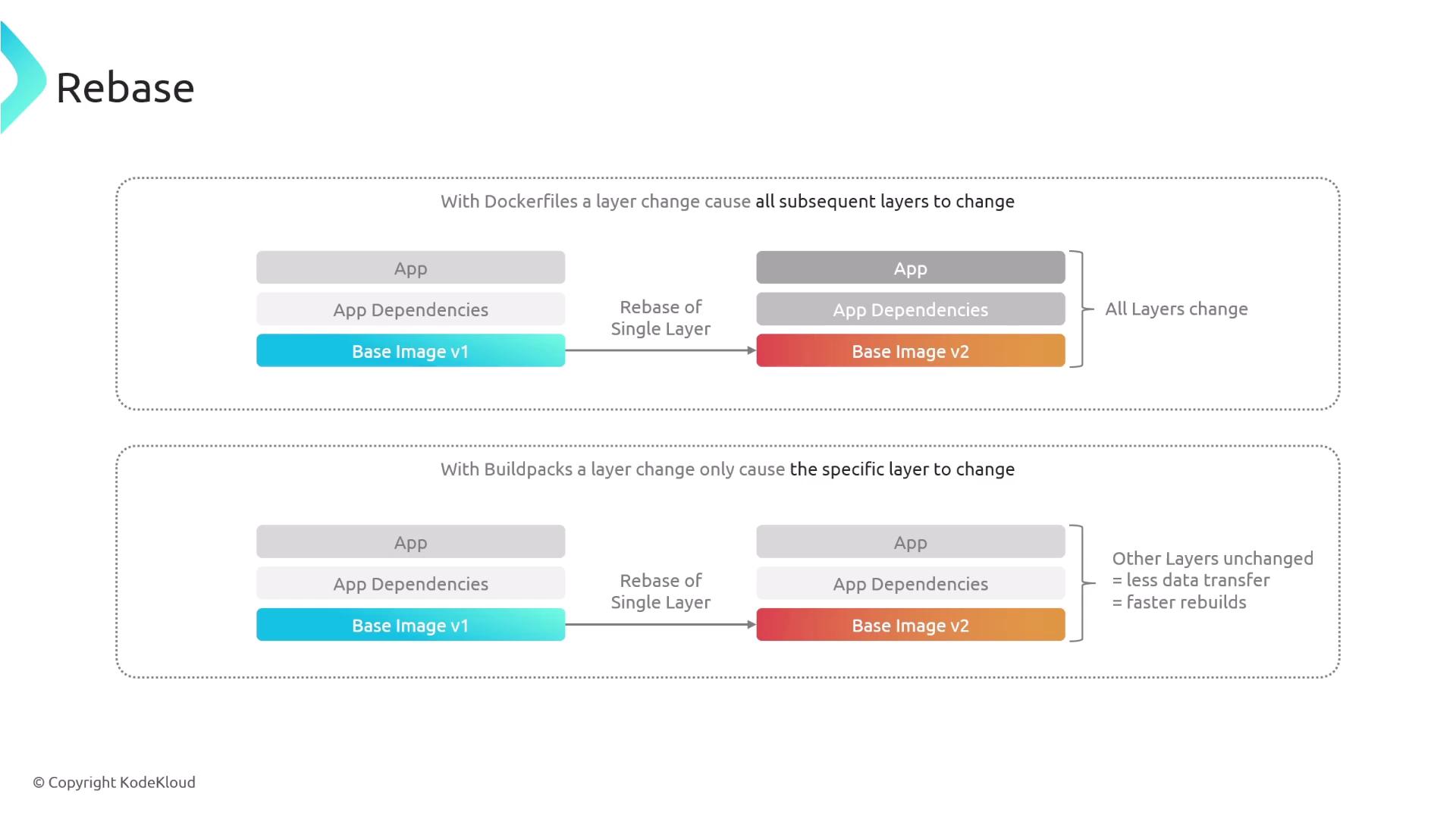Cloud Native Buildpacks
Buildpacks Basics
Rebase
In this guide, we'll explore the rebase functionality offered by Buildpacks. Rebasing enables you to update the base image of an already built application without the need to rebuild all subsequent layers, resulting in a more efficient and faster update process.
How Rebasing Works
When using a traditional Dockerfile, the first layer of an image is typically the base image, followed by additional layers that include application dependencies and source code. Any change to the base image—such as an operating system update, applying a hotfix, addressing a security vulnerability, or adding new dependencies—requires rebuilding every layer above it. This process can be resource-intensive and inefficient.
Buildpacks streamline this process. When you rebase an image with an updated base image, only the base layer is replaced, while the higher-level layers remain unchanged. This targeted replacement minimizes rebuild time and data transfer during the image update process.

Note
Rebasing significantly improves your build performance by only updating the necessary layer. This makes it an ideal approach when you need to apply minor changes or security fixes.
Inspecting the Image
Before proceeding with a rebase operation, you can inspect the current image details using the Pack CLI. Run the following command:
pack inspect my-image
A sample output might appear as follows:
Inspecting image: my-image
REMOTE:
(not present)
LOCAL:
Stack:
Base Image:
Reference: 36862ffaa256b69f1c92251e433dbe12c522f8d6d1476e792599f20c9fcb532c
Top Layer: sha256:130264b17d64b99aa2091e0664a5e0dbf6ead305d43cd674073311917390ed48
Run Images:
run-base:v1
Rebasable: true
Buildpacks:
ID VERSION HOMEPAGE
my-js-buildpack 0.0.1 -
samples/hello-world 0.0.1 https://github.com/buildpacks/samples/tree/main/buildpacks/hello-world
samples/hello-moon 0.0.1 https://github.com/buildpacks/samples/tree/main/buildpacks/hello-moon
Processes:
TYPE SHELL COMMAND ARGS WORK DIR
web (default) node index.js /workspace
In this output, note the Run Images field, which displays the current base image (run-base:v1).
Rebasing the Image
If you need to update the base image—whether to apply a hotfix, address security vulnerabilities, or add new dependencies—and have created an updated base image (for example, run-base:v2), you can perform a rebase with the following command:
pack rebase my-image --run-image run-base:v2
This command substitutes the old base image (run-base:v1) with the new one (run-base:v2) without rebuilding the remaining layers.
Warning
Ensure that your updated base image has been thoroughly tested before performing the rebase in production. This helps avoid any unexpected issues.
Verifying the Rebase
After executing the rebase command, verify that the image now uses the updated base by inspecting it again:
pack inspect my-image
An updated output should indicate the change as shown below:
Inspecting image: my-image
REMOTE:
(not present)
LOCAL:
Stack:
Base Image:
Reference: 36862ffaa256b69f1c92251e433dbe12c522f8d6d1476e792599f20c9fcb532c
Top Layer: sha256:130264b17d64b99aa2091ee0664a5e0dbf6ead305d43cd67407331191739e0d48
Run Images:
run-base:v2
Rebasable: true
Buildpacks:
ID VERSION HOMEPAGE
my-js-buildpack 0.0.1 -
samples/hello-world 0.0.1 https://github.com/buildpacks/samples/tree/main/buildpacks/hello-world
samples/hello-moon 0.0.1 https://github.com/buildpacks/samples/tree/main/buildpacks/hello-moon
This confirms that the new base image (run-base:v2) is now active, highlighting the efficiency and convenience of using Buildpacks for rebasing.
For more detailed information on Buildpacks and image creation, consider reviewing these resources:
Watch Video
Watch video content